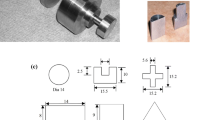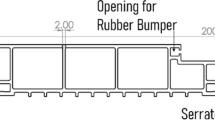Abstract
This study addresses the issue of quality consistency in the extrusion process of energetic materials using multi-channel dies. To improve the extrusion efficiency of single-base energetic materials, a multi-channel die approach is utilized to yield more products in one extrusion. However, this method may compromise quality consistency during the process. Consequently, the finite element method (FEM) was employed for dynamics simulation of the extrusion process in the multi-channel die and further analysed the impact of critical parameters, such as extrusion speed and channel position, on product quality consistency. A strong linear relationship between flow parameters and \({d}_{c}\), the average distance from each channel to the center of the die outlet plane, was reveal from simulation results. An optimization method based on channel distribution was proposed, and the product quality consistency ratio was calculated by averaging the shape consistency ratio, surface quality consistency ratio, and density consistency ratio. Simulation results indicate that this method effectively improves product quality consistency without significantly compromising extrusion efficiency. However, while increasing piston speed can also enhance product quality consistency, it will raise the extrusion pressure, thus increasing the risk of energetic material burning. Overall, this research provides new theoretical underpinnings and practical methods for optimizing the extrusion process of energetic materials. The basic theory, formula, algorithm, and simulation will be presented to validate the correctness and feasibility of the proposed method.























Similar content being viewed by others
Data availability
Data sharing not applicable, as this article describes a method of dynamics modeling and analysis, and the data supporting this study has been available within the article.
References
Martínez-Pastor J, Franco P, Moratilla D, Lopez-Garcia PJ (2018) optimization of forming processes for gelled propellant manufacturing. In: Ram M, Davim J (eds) Modeling and Simulation in Industrial Engineering. Management and Industrial Engineering. Springer Cham, 1–28. https://doi.org/10.1007/978-3-319-60432-9_1
Kalyon DM, Gevgilili H, Kowalczyk JE, Prickett SE, Murphy CM (2006) Use of adjustable-gap on-line and off-line slit rheometers for the characterization of the wall slip and shear viscosity behavior of energetic formulations. J Energ Mater 24:175–193. https://doi.org/10.1080/07370650600791080
Martínez-Pastor J, Franco P, Ramirez FJ, Lopez-Garcia PJ (2016) Influence of rheological behavior on extrusion parameters during non-continuous extrusion of multi-base propellants. Int J Mater Form 11(1):87–99. https://doi.org/10.1007/s12289-016-1332-5
Martinez-Pastor J, Franco P, Ramirez FJ (2014) Rheological characterization of energetic materials by rotational testing techniques. Proceedings of ESDA 2014: 12th Biennial Conference on Engineering Systems Design and Analysis, Copenhagen, Denmark. https://doi.org/10.1115/ESDA2014-20400
Qi L, Ma Z, Liang J, Xiao Z (2020) Effect of solid additives on the rheological property of nitroglycerin plasticized nitrocellulose. Appl Rheol 30(1):14–26. https://doi.org/10.1515/arh-2020-0002
Qiuwen Z, Zhen J, Wenhui N, Yan L, Ning G (2022) Numerical investigation of mass transfer behavior of a gas–liquid two‐phase Taylor flow in a microchannel by a volume‐of‐fluid multiphase flow system. Int J Mech Syst Dyn 2(3):253–264. https://doi.org/10.1002/msd2.12049
Xiaoting R, Jianshu Z, Xun W, Bao R, Bin H, Zhan J (2022) Multibody system transfer matrix method: The past, the present, and the future. Int J Mech Syst Dyn 2(1):3–21. https://doi.org/10.1002/msd2.12037
Zhu C, Nan F, Liang Y (2018) Numerical simulation of extrusion molding of single-hole propellant. Mater Sci Forum 917:269–275. https://doi.org/10.4028/www.scientific.net/MSF.917.269
Ji D, Liu Z, Liao X, Lv S, Wang Z (2016) Numerical simulation of extrusion process and die optimization for 19-hole propellant. Chin J Energ Mater 24(11):1114–1120. https://doi.org/10.11943/j.issn.1006-9941.2016.11.015
Chang F, Nan F, He W (2017) Numerical simulation and verification of porous nitroguanidine gun propellant extrusion. Chin J Energ Mater 25(2):106–112. https://doi.org/10.11943/j.issn.1006-9941.2017.02.003
Ji D, Liao X (2014) Finite element simulation of seven-hole propellant extrusion and the optimization of die compression ratio. Adv Mater Res 941:2373–2377. https://doi.org/10.4028/www.scientific.net/AMR.941-944.2373
Martínez-Pastor J, Franco P, Moratilla D, Lopez-Garcia PJ, Faura F (2017) Simulation of gelled propellant doughs isothermal flow through extrusion dies using finite difference method. Procedia Manufacturing 13:410–417. https://doi.org/10.1016/j.promfg.2017.09.033
Oyinloye TM, Yoon WB (2021) Application of computational fluid dynamics (CFD) simulation for the effective design of food 3D printing (a review). Processes 9:1867. https://doi.org/10.3390/pr9111867
Versteeg HK, Malalasekera W (2007) An introduction to computational fluid dynamics: the finite volume method. Pearson Education, Harlow, UK
Yang F, Guo C, Zhang M, Bhandari B, Liu Y (2019) Improving 3D printing process of lemon juice gel based on fluid flow numerical simulation. LWT 102:89–99. https://doi.org/10.1016/j.lwt.2018.12.031
Prabhakara S, Deshpande MD (2004) The no-slip boundary condition in fluid mechanics. Resonance 9:61–71. https://doi.org/10.1007/BF02834016
Kalaycioglu B, Dirikolu MH, Çelik V (2010) An elasto-viscoplastic analysis of direct extrusion of a double base solid propellant. Adv Eng Softw 41:1110–1114. https://doi.org/10.1016/j.advengsoft.2010.07.001
Martinez-Pastor J, Franco P, Oton-Martinez RA (2019) Rheology of double-base gelled propellants as the basis for extrusion process modelling: influence of normal force on slip layer and flow curves. Int J Mater Form 13(2):219–233. https://doi.org/10.1007/s12289-019-01480-9
Fortin M (1981) Old and new finite elements for incompressible flows. Int J Numer Methods Flsuids 4(1):347–364. https://doi.org/10.1002/fld.1650010406
Rueda MM, Auscher MC, Fulchiron R, Périé T, Martin G, Sonntag P, Cassagnau P (2016) Rheology and applications of highly filled polymers: a review of current understanding. Prog Polym Sci 66:22–53. https://doi.org/10.1016/j.progpolymsci.2016.12.007
Yang F, Zhang M, Bhandari B, Liu Y (2018) Investigation on lemon juice gel as food material for 3D printing and optimization of printing parameters. LWT 87:67–76. https://doi.org/10.1016/j.lwt.2017.08.054
Valkenaers H, Jansen D, Voet A, Van Gysel A, Ferraris E (2014) Additive manufacturing for concrete: a 3D printing principle. 14th International Conference of the European Society for Precision Engineering & Nanotechnology, Dubrovnik(HR), pp 139–142.
Morton MD (2001) Extrusion instabilities and wall slip. Annu Rev Fluid Mech 33:265–287. https://doi.org/10.1146/annurev.fluid.33.1.265
Wang L, Zhang M, Bhandari B, Yang C (2017) Investigation on fish surimi gel as promising food material for 3D printing. J Food Eng 220:101–108. https://doi.org/10.1016/j.jfoodeng.2017.02.029
Funding
The research was supported by the National Natural Science Foundation of China (Grant No: 11972193, 92266201).
Author information
Authors and Affiliations
Contributions
All authors contributed to the study conception and design. Rheological experiment, extrusion tests, data collection, CFD computation, and analysis were performed by Jingyu Zou, Bao Rong. Material preparation, data collection were performed by Xiaoting Rui and Guoping Wang. The CAD modelling were performed by Yibo Liu. The first draft of the manuscript was written by Jingyu Zou and all authors commented on previous versions of the manuscript. All authors read and approved the final manuscript.
Corresponding author
Ethics declarations
Conflict of interest
The authors declare no competing interests.
Additional information
Publisher's Note
Springer Nature remains neutral with regard to jurisdictional claims in published maps and institutional affiliations.
Rights and permissions
Springer Nature or its licensor (e.g. a society or other partner) holds exclusive rights to this article under a publishing agreement with the author(s) or other rightsholder(s); author self-archiving of the accepted manuscript version of this article is solely governed by the terms of such publishing agreement and applicable law.
About this article
Cite this article
Zou, J., Rong, B., Liu, Y. et al. Dynamics simulation and product quality consistency optimization of energetic material extrusion process. Int J Adv Manuf Technol 131, 1497–1514 (2024). https://doi.org/10.1007/s00170-024-13185-8
Received:
Accepted:
Published:
Issue Date:
DOI: https://doi.org/10.1007/s00170-024-13185-8




